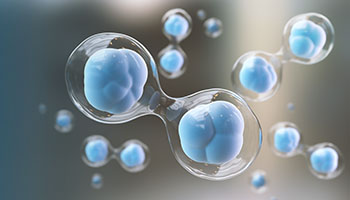HOW CAN WE HELP YOU? Call 1-800-TRY-CHOP
In This Section
Researchers Identify Gene Responsible for Impaired Stem Cell Regeneration

Researchers identify a gene linked to impaired stem cell regeneration via ribosome assembly.
shafere1 [at] chop.edu (By Emily Shafer)
Researchers at Children’s Hospital of Philadelphia identified a protein coding gene, HectD1, that appears to be responsible for hematopoietic stem cell (HSC) regeneration via ribosome assembly, paving the way for potential therapies — including gene therapy — for children with ribosomopathies.
Ribosomopathies are a group of inherited bone marrow failure disorders that result from impaired ribosome function. Patients with these disorders are deficient in HSCs and are predisposed to increased risks for leukemia and cancer. One example of ribosomopathies is Shwachman-Diamond syndrome, which is linked to mutations in ribosome assembly factors.
Assembly factors work by pairing a large subunit to a small subunit, and together, the subunits work to translate mRNA into proteins. The new study, which appears in Cell Stem Cell, found that the ribosomal assembly factor ZNF622 mediates the function of HectD1 in HSC regeneration.
“Previous research showed that mutations affecting ribosome assembly are associated with bone marrow dysfunction,” said Wei Tong, PhD, investigator in the Division of Hematology at CHOP, professor of Pediatrics at Perelman School of Medicine at the University of Pennsylvania, and senior author of the paper. “However, the mechanism that ensures the proper ribosome assembly was not well understood. We found that HectD1 appears to control the ribosome assembly and protein translation, which in turn regulates the HSC function.”
When the blood system is under stress, such as during inflammation, infection, or injury, the E3 ubiquitin ligase HectD1 tags ZNF622 for destruction, which allows the ribosome assembly to occur to ramp up protein production in the cell. However, when cells lack the HectD1 gene, ZNF622 continues to accumulate. This prevents the large and small subunits from joining, resulting in insufficient HSC production.
Working with a mouse model, Dr. Tong and her team found that by knocking down the Znf622 gene in HSCs that lack HectD1M gene, the large and small units are able to join again, which leads to restored HSC production. This finding highlights the potential to use gene therapy to treat these disorders, such as using CRISPR to edit the gene.
“We found a mechanism that prevents ribosomes from assembling properly in mammals, leading to stem cell defects, which could potentially be exploited in future therapeutic interventions,” Dr. Tong said. “These findings not only highlight the connection between protein degradation, ribosome assembly, and stem cell production, but they also reveal the potential for knocking down Znf622 to restore proper bone marrow function, which is critical for child development. Future research should look at this mechanism as a potential target for patients with these disorders.”